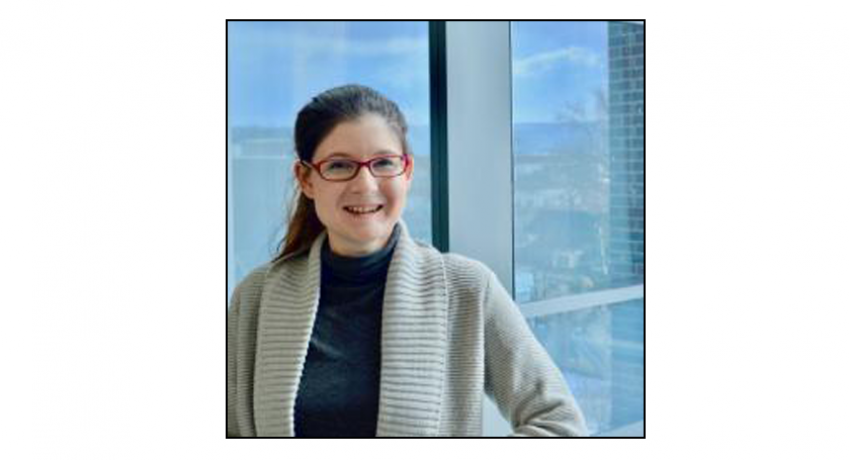Lauren Zarzar
Written by Krista Weidner
That constant change is what motivates materials scientist Lauren Zarzar in her research.
“The world around us is always changing—materials are constantly being exposed to different external pressures, external stimuli,” says Zarzar, assistant professor of materials science and engineering and assistant professor of chemistry. “Many materials we use are static in their properties and functions, but I’m interested in designing materials that respond to changes in the environment.”
Zarzar received her Ph.D. in chemistry from Harvard in 2013 and joins Penn State after completing her postdoctoral work at MIT, where she focused her research on dynamic materials that sense and adapt to their surroundings—in particular, microscale materials that move in response to a stimulus such as a change in temperature, pH, or humidity.
The Greek philosopher Heraclitus is quoted as saying, “Change is the only constant in life.”
3D printing on a micro scale
One of Zarzar’s major research focuses at Penn State is direct laser writing of metals and oxides to create patterns on a micro scale. “Direct writing, similar to additive manufacturing or 3D printing, lets you pattern a material in whatever shape you want and deposit it directly where you want it, with no need for a mold or mask,” Zarzar says. “Although this technique has been gaining popularity, there hasn’t been as much work in depositing inorganic materials, such as metals, on a micro scale.”
When Zarzar began thinking about using laser lithography to deposit metals, she was interested in using platinum because platinum is a catalyst—a substance that increases the rate of a chemical reaction but doesn’t itself undergo a permanent chemical change. She had the idea to create a three-dimensional active structure (a pump, in this case) by causing platinum to interact with a hydrogen peroxide solution.
“When I started wondering what chemistry I would use to deposit platinum using light from a laser, I read some of the literature on photography,” she says. “And I came upon information about platinum-type photography. It’s fairly common knowledge that silver was used to make photographs in the 1800s, but I was surprised to learn it was also done with gold as well as platinum. So as early as the 1800s the chemistry had been developed to make photographs with platinum nanoparticles. It was exciting to be able to demonstrate that we can use this chemistry in direct material deposition with laser lithography.”
In initial experiments, when Zarzar deposited the platinum with a light-induced process, she noticed that when the laser light hit the platinum, the surrounding solution would heat up quickly, allowing her to induce new reactions. Next steps in her research will involve exploring a thermal approach in the direct depositing process as well as depositing materials other than platinum. Direct depositing of metals and oxides has potential applications for direct-write circuits, sensors, catalysts, and electrodes.
Drop by drop
Zarzar’s second major research focus is looking at how emulsions of different fluids interact with chemicals in their environment. She creates complex droplets that include two different immiscible oils—or oils that don’t form a homogeneous mixture when they’re added together—and changes the droplets’ shape by adding various chemicals to the solution. “By adding chemicals like a surfactant, such as soap,” she says, “we can change how the droplets respond to a range of stimuli.”
Emulsification, Zarzar explains, is a well-known and powerful technique for mixing and dispersing components through liquid, and emulsions are critical components of many medicines and foods. Complex emulsion properties and functions are related to the droplet structure and are becoming increasingly important in pharmaceuticals and medical diagnostics, cosmetics, and optics.
Zarzar credits her graduate research advisor at Harvard, Joanna Aizenberg, for sparking her interest in responsive and adaptive materials. “I started working on projects in this area as a new graduate student in her group, and I was immediately fascinated,” she says. “It’s exciting work, and it’s fun—you get to take movies when you study active materials.”
For Zarzar, research can be approached in different ways. “Sometimes, I have a definite idea and I know what materials I’m going to use and what I want to accomplish from the onset,” she says. “Other times I see something interesting or unusual along the way and go back to figure it out and delve into it more deeply.”
Beyond research
Zarzar and her husband moved to the State College area from Cambridge during the summer, and she began her position with Penn State on August 1. Her husband, whom she met at Harvard during graduate school, is a lecturer in the Department of Chemistry and involved in developing chemistry courses for Penn State World Campus. “Penn State was a good fit for both of us,” she says.
During fall semester, Zarzar is busy setting up her lab and training two graduate students and one undergraduate. She’ll begin teaching the undergraduate course Introduction to Polymer Materials during spring semester. She was recently named the Virginia S. and Philip L. Walker Jr. Faculty Fellow in Materials Science and Engineering.

